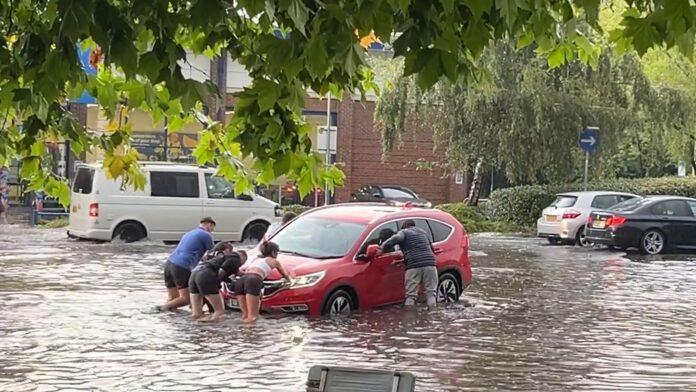Thousands of England’s flood defences designed to protect people’s homes and businesses are inadequate, government data suggests.
Of the key infrastructure designed to protects homes and businesses from wet weather, 92.6% is up to scratch, according to figures from the environment department (Defra).
Government sources say the figure is “significantly below the optimum level of 98%”, and the lowest it has been since 2009/10.
For every one percentage-point drop in defences in top condition, an extra 10,000 properties could be placed at risk by heavy downpours, officials added.
However, the Environment Agency, which manages 75,000 flood defences in England, say it installs temporary protections while defences are being repaired, meaning degraded assets do not always increase the flood risk.
The news comes after the Met Office last week warned that wetter-than-average weather was likely this autumn and winter.
Substandard defences are one of many issues plaguing the industry, just as a hotter climate is increasing the risk of flooding, while paved urban areas leave water nowhere to go.
New homes are being built without necessary flood defences in spite of warnings, MPs warned in January, while the government has no “effective strategy” to protect the UK from disruption from things like flooding, the NAO said last year.
A record-breaking 18 months of rain last year brought misery to UK farmers, who struggled to harvest or sometimes even plant crops, leaving shoppers to pay higher prices, analysis by thinktank ECIU has found.
Last week the new environment secretary Steve Reed convened a new Floods Resilience Taskforce, hoping to boost flood defences and strategies and join up responses between different authorities.
The group, which so far has no additional funding or powers, aims to take a more long-term, strategic approach to the challenges of flooding, officials said.
The country’s independent advisers on such assets, the National Infrastructure Commission (NIC), is urging the government to bring in measurable targets for reducing flood risk, to help quantify the amount of investment needed.
An NIC spokesperson said: “A changing climate requires a reassessment of the costs of maintaining assets to help inform future spending cycles, which the Commission has recommended should also be focused on delivering a measurable reduction in the number of properties at risk of flooding.”
The government has not yet said whether it will bring in such a target, or increase the flood resilience budget.
The Environment Agency (EA) said it this year increased inspection of defences to 216,000, up from 150,000 in an average year, following the “unprecedented storms we faced last winter”.
It also increased spending on maintenance from £200m to £236m.
Read more from Sky News:
At least eight dead as eastern and central Europe struck by torrential rain and flooding
Mega-tsunami caused Earth to vibrate for nine days, study shows
Shy and rare penguin wins New Zealand’s Bird Of The Year
“Our defences protected over 282,000 properties during last winter’s storms – and we prioritise maintenance where there is a significant threat to lives and livelihoods,” an EA spokesperson said in a statement.
“If the performance of an asset is reduced, we will take action to ensure that flood risk is effectively managed until the asset is fully repaired or replaced.”
👉 Tap here to follow Politics at Jack and Sam’s wherever you get your podcasts 👈
The environment secretary Steve Reed said: “Thanks to 14 years of mismanagement and failure, communities have been left unprotected, and families and businesses forced to pay the price.
“Labour is acting now to speed up the building of flood defences and bolster our emergency response.”


